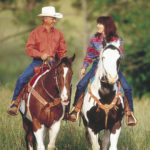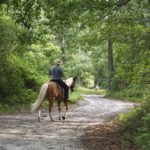Caring for a horse or pony at home is a serious responsibility. “Good horsekeeping requires dedication and a lot of time and energy,” notes Cherry Hill, author of numerous books and videos on horsemanship and horse husbandry (www.HorseBooksEtc.com or horsekeeping.com). “It’s a daily, ongoing commitment.”
Moreover, though horsekeeping at home can save a bit compared to the cost of boarding a horse out, it’s nevertheless a considerable expense.?Still, having a horse in your backyard, so to speak, can be fun, and it provides your child with maximum opportunity to enjoy her equine friend.
If you’re not already experienced with horses, your most important task in preparing to care for one will be to consult with your child’s instructor regarding the unique aspects of the job in the climate where you live. A local equine veterinarian can also be a good source; so can your county’s cooperative extension office. (Go to www.myhorsematters.com, the official Web site of the American Association of Equine Practitioners, for help finding a veterinarian in your area. To find your county extension agent, look in the government listing section of your phone book, under the name of your county.)
Living Quarters. There are several different suitable arrangements for keeping a horse. All of them require adequate shelter from harsh weather, plenty of opportunity for exercise, and enclosures that are safe and secure.
Space and shelter. In a pasture is the most natural way for a horse to live, but it requires a good deal of land. Check with your county extension agent for the “carrying capacity” of the area where you live, which will depend in part on whether your land is irrigated. A pen or a paddock are smaller-space alternatives to pasture.
In each of these arrangements, your child’s horse or pony will need shelter from the hot sun in the summer, and from wind and rain or snow in the winter. Depending on your climate, adequate shelter might be a stand of trees, a run-in or loafing shed (three-sided, roofed structure), or access to a barn stall. Commercial companies now provide pre-fabricated barns in all sizes and configurations; you can also build your own less expensively (see how-to books in “Resources”).
A horse kept exclusively in a barn stall or a small pen will need daily exercise (riding and/or turn-out in an area large enough to gallop in). This is extremely important, both for the animal’s health and your child’s safety, as pent-up energy is the cause of much equine misbehavior. Stalls and small pens also require daily mucking out (manure removal).
Fencing. Safety and durability are your primary concerns. The market now offers a wide range of horse-safe fencing in various price ranges. Options include wood, vinyl, PVC rail, and woven-wire or chain link, as well as a variety of electrified tape, rope, and wire. Your child’s instructor or your local county extension agent can advise you on the best choice for your area and your budget. A combination of mesh and electric wire is often a cost-effective option. Unsuitable fencing includes any sort of barbed wire, or wire patterns that a horse can get a hoof through. (Horses are notorious for getting their feet caught in wire, with often disastrous results.)
Other Basics
Feed. Options range from the least-expensive basics?hay and (possibly) grain?to an endless variety of specially formulated commercial products. Again, let your child’s instructor and/or a local vet guide you. (Horses have surprisingly delicate digestive systems, and improper feeding is one of the leading causes of illness and death.)
Nature designed horses to eat small amounts all day long, so provide a minimum of two or (ideally) three or four feedings per day to avoid digestive disorders such as colic.
Keep in mind, too, that a good beginner’s horse isn’t likely to need as much concentrated feed (grain or commercial concentrates) as a high-performance animal, and may well do fine on hay alone. Overfeeding (even of too much rich pasture grass) is a common error, especially of ponies, and can result in laminitis or other serious health or behavior problems.
Free-choice salt (blocks are handy) and an abundant source of fresh water are requirements; vitamin and mineral supplements may also be helpful depending on the quality of your feed and your horse’s unique requirements (check with your vet).
Grooming. Daily grooming promotes equine health, reveals small injuries that need tending, and enhances the bond between your child and her horse. There are a variety of grooming tools available to accomplish the task; basics are a rubber currycomb (to loosen mud and caked dirt), a stiff dandy brush (to sweep away what the currycomb loosens), a soft body brush (for finishing touches), and a hoof pick (to clean out the feet).
Deworming/fly control. Deworm your child’s horse about every two months, using one of a variety of commercial pastes available at your local feed store (check with your vet). Fly control measures include removing manure piles (in which flies lay their eggs), setting out fly bait and traps, and applying insecticides and/or repellents to barn surfaces and the horse’s coat. Your county extension agent or a knowledgeable feed store clerk can guide you here.
Foot care. Whether or not your child’s horse wears shoes, he’ll need to be seen by a farrier or other foot care specialist every six to eight weeks for trimming. Be aware that horses that need special shoes (to offset a mild lameness) will require more frequent?and more expensive–farriery.
Veterinary care. Twice-yearly visits from the veterinarian are the norm for routine exams, vaccinations, and dental care (if needed). Additional visits to deal with injuries or illness will depend on your luck and your horsekeeping expertise.
Company. Horses hate to be alone, so if more than one equine isn’t an option, consider keeping a goat as your horse’s companion.
Transport. You’ll need a hauling rig (truck and horse trailer) or access to one for veterinary emergencies (as when your child’s horse needs specialized treatment that your local vet can’t provide), and for transport to and from lessons, shows, and other events.
COSTS OF BOARDING VS. HORSEKEEPING AT HOME
It’s difficult to estimate the cost of keeping a horse, as there are many variables, plus extenuating circumstances that often add to the bill. But here are some monthly ballpark figures:
*Boarding at a stable:
**Board: $25- 600
***Routine vet/farriery $50-$250
TOTAL: $75-$850
Keeping at home:
Feed: $50-$200
***Routine vet/farriery $50-$250
TOTAL: $100-$450
*Boarding options include pasture turnout, pen or paddock with shelter, or barn stall–with or without a run.
**Price range reflects the various options available for boarding as well as variations in stable-supplied care (from none to full care of a stalled animal).
***Yearly estimates amortized over 12 months.
For more related information related, go to:
www.equisearch.com/horses_riding_training/training/beginning_rider/horse_keeping091399c
www.equisearch.com/horses_care/farm_ranch/management/questions121203)






